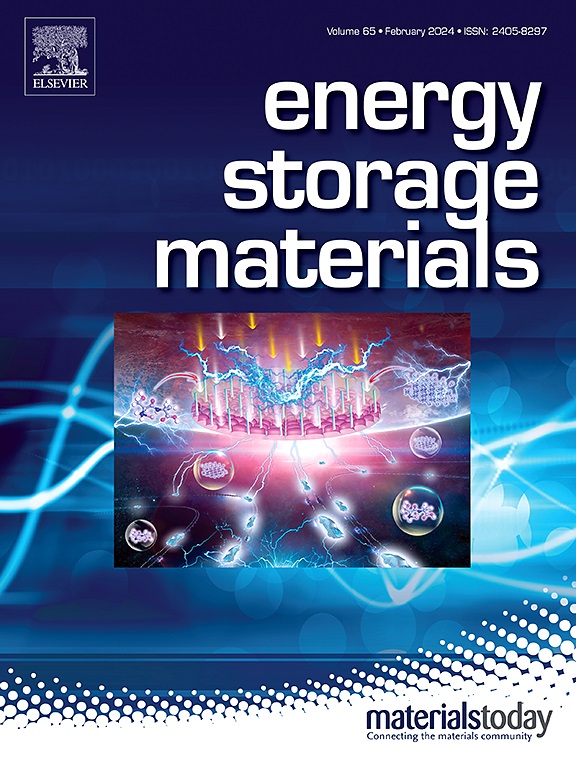Recycling-Regenerating Salt Enables the Economic Viability of Aqueous High-concentration Electrolytes
IF 18.9
1区 材料科学
Q1 CHEMISTRY, PHYSICAL
引用次数: 0
Abstract
The aqueous high-salt-concentrated electrolytes expand the electrochemical stability window (ESW), providing aqueous batteries with high output voltage and energy density. However, the increased salt concentration also raises costs, negatively affecting the economic feasibility for electric energy storage. Herein, we demonstrate that the aqueous highly concentrated lithium trifluoromethyl sulfonamide (LiTFSI) electrolytes are easy to recycle through salt extraction methods. Furthermore, to circumvent energy-intensive dehydration processes induced by LiTFSI hygroscopicity, we propose a direct regeneration protocol based on concentration-density correlation. The recycled/regenerated electrolytes maintain similar physical and chemical properties comparable to pristine electrolytes, exhibiting a wide ESW of 3 V. Pouch cells (0.5 Ah) assembled with the recycled and regenerated electrolyte exhibit equivalent performance to the pristine electrolyte, maintaining a capacity of over 87% after 300 cycles. Techno-economic analysis indicates that recycling salt reduces costs by 69.3% and regeneration electrolyte by 71.2%, both of which require wastewater treatment amounting to merely 5.6% of salt production. Remarkably, regeneration achieves substantial reductions in energy consumption (93.9%) and CO2 emissions (94.8%) by eliminating energy-intensive drying processes, surpassing salt recycling's 85.4% and 87.9% reductions. Our work aims to provide a cost-effective and sustainable solution for using high-concentration electrolytes, enabling the practical implementation of aqueous lithium-ion batteries.

盐的回收再生使高浓度水电解质具有经济可行性
含水高盐浓度电解质扩大了电化学稳定窗口(ESW),为含水电池提供了高输出电压和能量密度。然而,盐浓度的增加也提高了成本,对电力储能的经济可行性产生了负面影响。在此,我们证明了水溶液高浓度三氟甲基磺酰胺锂(LiTFSI)电解质易于通过盐萃取法回收。此外,为了避免由LiTFSI吸湿性引起的能量密集型脱水过程,我们提出了一种基于浓度-密度相关性的直接再生方案。回收/再生电解质与原始电解质保持相似的物理和化学性质,具有3 V的宽ESW。用回收和再生电解质组装的袋状电池(0.5 Ah)表现出与原始电解质相当的性能,在300次循环后保持超过87%的容量。技术经济分析表明,回收盐可降低69.3%的成本,再生电解质可降低71.2%的成本,而这两种方法所需的废水处理量仅占盐产量的5.6%。值得注意的是,再生技术通过消除能源密集型干燥过程,实现了能源消耗(93.9%)和二氧化碳排放(94.8%)的大幅降低,超过了盐回收的85.4%和87.9%。我们的工作旨在为使用高浓度电解质提供一种具有成本效益和可持续的解决方案,使含水锂离子电池能够实际实施。
本文章由计算机程序翻译,如有差异,请以英文原文为准。
求助全文
约1分钟内获得全文
求助全文
来源期刊

Energy Storage Materials
Materials Science-General Materials Science
CiteScore
33.00
自引率
5.90%
发文量
652
审稿时长
27 days
期刊介绍:
Energy Storage Materials is a global interdisciplinary journal dedicated to sharing scientific and technological advancements in materials and devices for advanced energy storage and related energy conversion, such as in metal-O2 batteries. The journal features comprehensive research articles, including full papers and short communications, as well as authoritative feature articles and reviews by leading experts in the field.
Energy Storage Materials covers a wide range of topics, including the synthesis, fabrication, structure, properties, performance, and technological applications of energy storage materials. Additionally, the journal explores strategies, policies, and developments in the field of energy storage materials and devices for sustainable energy.
Published papers are selected based on their scientific and technological significance, their ability to provide valuable new knowledge, and their relevance to the international research community.
 求助内容:
求助内容: 应助结果提醒方式:
应助结果提醒方式:


